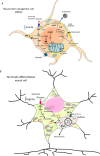Emerging Functional Connections Between Metabolism and Epigenetic Remodeling in Neural Differentiation
- PMID: 38340204
- PMCID: PMC11339152
- DOI: 10.1007/s12035-024-04006-w
Emerging Functional Connections Between Metabolism and Epigenetic Remodeling in Neural Differentiation
Abstract
Stem cells possess extraordinary capacities for self-renewal and differentiation, making them highly valuable in regenerative medicine. Among these, neural stem cells (NSCs) play a fundamental role in neural development and repair processes. NSC characteristics and fate are intricately regulated by the microenvironment and intracellular signaling. Interestingly, metabolism plays a pivotal role in orchestrating the epigenome dynamics during neural differentiation, facilitating the transition from undifferentiated NSC to specialized neuronal and glial cell types. This intricate interplay between metabolism and the epigenome is essential for precisely regulating gene expression patterns and ensuring proper neural development. This review highlights the mechanisms behind metabolic regulation of NSC fate and their connections with epigenetic regulation to shape transcriptional programs of stemness and neural differentiation. A comprehensive understanding of these molecular gears appears fundamental for translational applications in regenerative medicine and personalized therapies for neurological conditions.
Keywords: Chromatin; Energy metabolism; Epigenetics; Neural stem cells; Neurogenesis; Transcriptional regulation.
© 2024. The Author(s).
Conflict of interest statement
The authors declare no competing interests.
Figures


Similar articles
-
An epigenetic signature of developmental potential in neural stem cells and early neurons.Stem Cells. 2013 Sep;31(9):1868-80. doi: 10.1002/stem.1431. Stem Cells. 2013. PMID: 23712654
-
Geminin regulates the transcriptional and epigenetic status of neuronal fate-promoting genes during mammalian neurogenesis.Mol Cell Biol. 2012 Nov;32(22):4549-60. doi: 10.1128/MCB.00737-12. Epub 2012 Sep 4. Mol Cell Biol. 2012. PMID: 22949506 Free PMC article.
-
Ganglioside Microdomains on Cellular and Intracellular Membranes Regulate Neuronal Cell Fate Determination.Adv Neurobiol. 2023;29:281-304. doi: 10.1007/978-3-031-12390-0_10. Adv Neurobiol. 2023. PMID: 36255679 Free PMC article.
-
Neural Stem Cells and Nutrients: Poised Between Quiescence and Exhaustion.Trends Endocrinol Metab. 2016 Nov;27(11):756-769. doi: 10.1016/j.tem.2016.06.007. Epub 2016 Jul 4. Trends Endocrinol Metab. 2016. PMID: 27387597 Review.
-
Epigenetic mechanisms in sequential differentiation of neural stem cells.Epigenetics. 2009 Feb 16;4(2):89-92. doi: 10.4161/epi.4.2.8233. Epub 2009 Feb 18. Epigenetics. 2009. PMID: 19287212 Review.
Cited by
-
MetaboLINK is a novel algorithm for unveiling cell-specific metabolic pathways in longitudinal datasets.Front Neurosci. 2025 Jan 13;18:1520982. doi: 10.3389/fnins.2024.1520982. eCollection 2024. Front Neurosci. 2025. PMID: 39872998 Free PMC article.
-
Unraveling Neurodevelopment: Synergistic Effects of Intrinsic Genetic Programs and Extrinsic Environmental Cues.Adv Sci (Weinh). 2025 Jun;12(22):e2414890. doi: 10.1002/advs.202414890. Epub 2025 May 5. Adv Sci (Weinh). 2025. PMID: 40323170 Free PMC article. Review.
-
Reflections on the Role of Differentiation Processes in Forming Behavioral Phenotypes: Can These Processes Replace the Concepts of Plastic Phenotype and Reversible Plastic Phenotype?Biology (Basel). 2025 Feb 12;14(2):187. doi: 10.3390/biology14020187. Biology (Basel). 2025. PMID: 40001955 Free PMC article.
References
Publication types
MeSH terms
LinkOut - more resources
Full Text Sources

